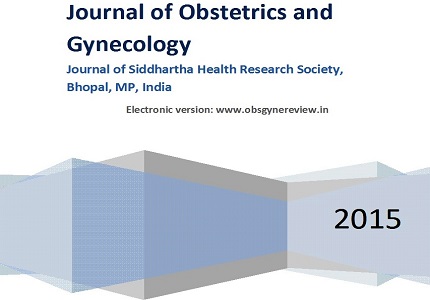Primary amenorrhoea – a single centre experience of 38 cases
Abstract
Introduction: Primary amenorrhoea is defined as absence of menstruation by the age of 14 in absence of secondary sexual characteristics & by age 16 regardless of the presence or absence of secondary sexual characteristics. It occurs in around 1-4% of women in reproductive age group. The common causes of primary amenorrhoea include outflow tract disorders or uterine abnormalities, ovarian disorders, pituitary dysfunction, and hypothalamic dysfunction. The data of primaryamenorrhoea from our country is limited due to poor reporting and frequent loss to follow up. Hence we undertook this prospective study to determine the etiology for primary amenorrhoeabased on clinical examination and laboratory investigations.
Methodology: This prospective study was done in Gynecologic Clinic of Sunrise Hospital between August 2013 to May 2015. The work up of primary amenorrhoea patients comprised of 1) History taking 2) Physical examination 3) Laboratory investigations. Patients were classified into 5 groups based on the compartment of organs involved.I- End organ failure/ outflow tract obstruction, II- Gonadal failure, III- Pituitary cause, IV- Hypothalamic cause, V- Other causes.
Results: In our study, the 2 most common etiologic factors of primary amenorrhoeawere mullerian agenesis (65.78%) and gonadal dysgenesis (21.05%). Hypogonadotrophichypogonadism was noted in 10.52% of cases. Range of average age of the patients when they first consulted the physician was 14 to 33 years.
Conclusion: Prompt reporting and awareness of available treatment options based on the etiology can make a huge difference in this often underreported disorder.
Downloads
References
2. S.S. Ratnam , R. JothiKumar.Amenorrhoea, Obstetric and gynecology for post graduate. 2nd Edition-1999; Vol.-1, Page- 241.
3. Bachmann GA, Kemmann E. Prevalence of oligomenorrhea and amenorrhea in a college population.Am J Obstet Gynecol. 1982 Sep 1;144(1):98-102. [PubMed]
4. Pettersson F, Fries H, Nillius SJ. Epidemiology of secondary amenorrhea: incidence and prevalence rates. Am J Obstet Gynecol. 1973;117:80-86. [PubMed]
5. Master-Hunter T ,Heiman DL. Amenorrhea: Evaluation and treatment. Am Fam Physician 2006 Apr 15; 73(8): 1374–1382. [PubMed]
6. Meethal SV, Liu T, Chan HW, Ginsburg E, Wilson AC, Gray DN, Bowen RL, Vonderhaar BK, Atwood CS.. Identification of a regulatory loop for the synthesis of neurosteroids: A steroidogenic acute regulatory protein-dependent mechanism involving hypothalamic-pituitary-gonadal axis receptors. J Neurochem2009 Aug;110(3):1014-27. doi: 10.1111/j.1471-4159.2009.06192.x. [PubMed]
7. Aittomäki K, Eroila H, KajanojaP. A population-based study of the incidence of müllerian aplasia in Finland.FertilSteril 2001 Sep;76(3):624-5.
8. QuorrataEynulForhad, SumayyaTasnim ,Anowara Begum. Primary Amenorrhoea - Analysis of 44 cases; Bangladesh J ObstetGynaecol, 2008; Vol. 23(2) : 46-50. DOI: http://dx.doi.org/10.3329/bjog.v23i2.4958.
9. PrasongTanmahasamut, ManeeRattanachaiyanont, ChongdeeDangrat, SuchadaIndhavivadhana, Surasak Angsuwattana and KitiratTechatraisak. Causes of primary amenorrhea: A report of 295 casesin Thailand; J. Obstet. Gynaecol. Res. Vol. 38, No. 1: 297–301, January 2012; doi:10.1111/j.1447-0756.2011.01677.x.
10. Rattanachaiyanont M, Kunathikom S, Angsuwattana S, Techatraisak K, Mekmahan O, Karavagul C, Ko-Anantakul S. Primary amenorrhoea: A retrospective study at Siriraj Hospital. J Med Assoc Thai 1997 Oct; 80(10): 619-25. [PubMed]
11. Rao K, Pillai NV. Primary amenorrhoea (analysis of 40 cases).J Indian Med Assoc 1991; 89: 42–43.
12 Kumar A, Mittal S. Primary amenorrhoea: Analysis of 48 cases. J Indian Med Assoc. 1998 Apr; 96(4): 119-20. [PubMed]
13. Reindollar RH, Tho SPT, McDonough PG. Delayed puberty: An update study of 326 patients. Trans Am GynecolObstetSoc 1989; 8: 146–162.
14. James H. Evans; Aust. N.Z. J. Review of 50 Cases of Primary Amenorrhoea. Obstet. Gynaecol. 1971 11( 7) pg 7-12.DOI: 10.1111/j.1479-828X.1971.tb00443.x

Copyright (c) 2015 Author (s). Published by Siddharth Health Research and Social Welfare Society

This work is licensed under a Creative Commons Attribution 4.0 International License.


 OAI - Open Archives Initiative
OAI - Open Archives Initiative



















 Therapoid
Therapoid

